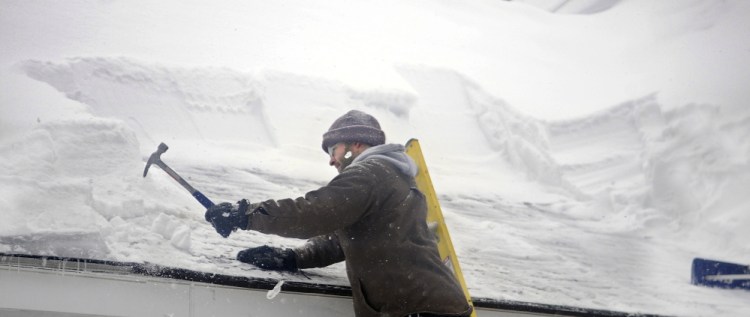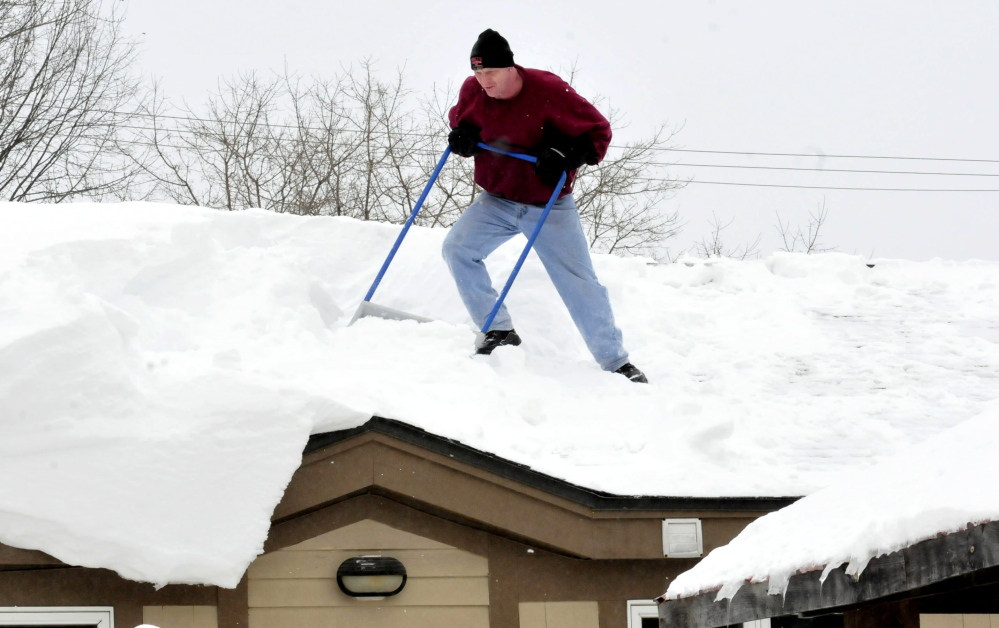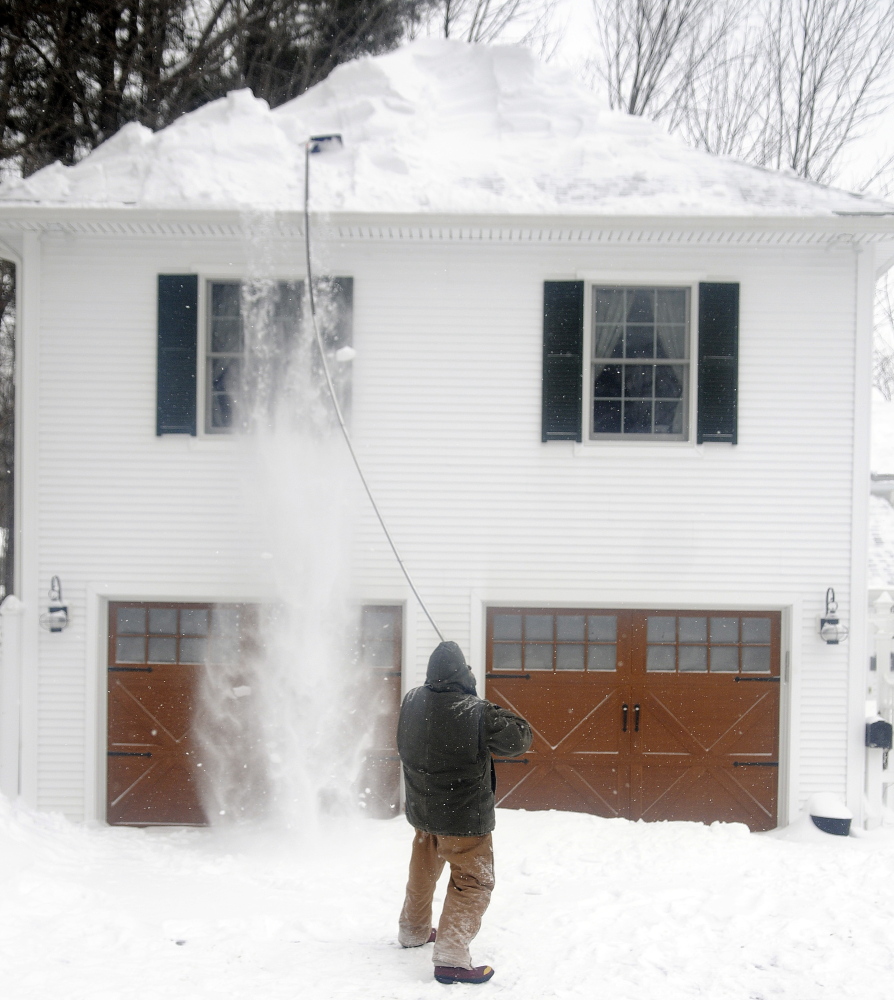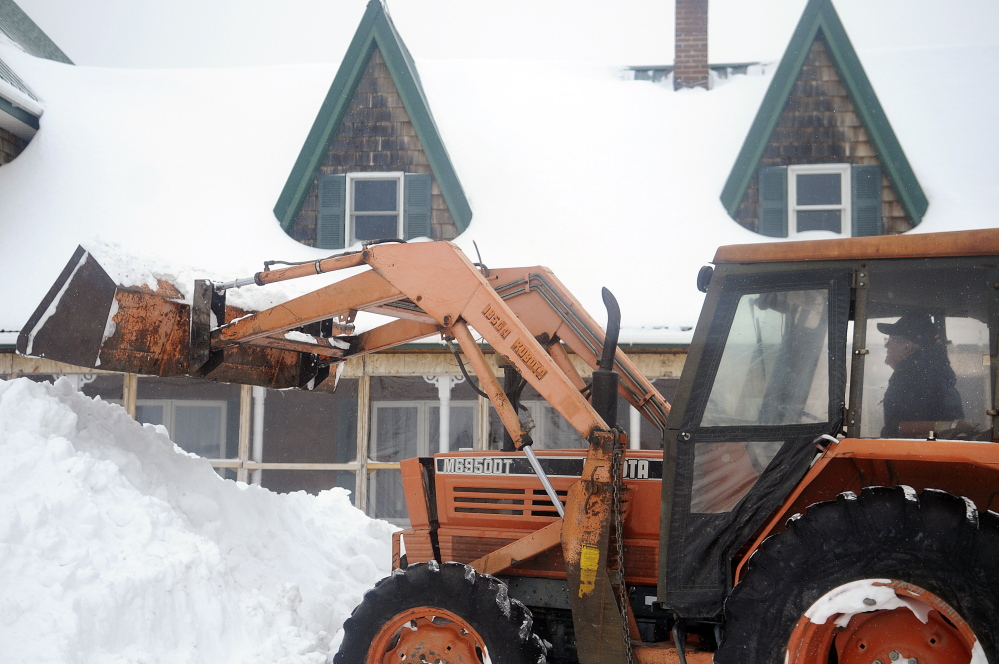The few feet of snow that had fallen on central Maine this year could create problems for building owners if the area gets rain before snow melts or is cleared off, said area fire chiefs and business that deal with snow removal.
Excessive snow on roofs, particularly flat roofs most commonly found on commercial property, can cause them to collapse, Augusta Fire Chief Roger Audette said.
Roofs are designed to withstand a certain amount of weight from snow, but when it rains after a lot of snow, the snow acts like a sponge, holding a hazardous amount of weight in one place, he said.
“I think most of the fire chiefs are hoping we don’t have to deal with big rains at the tail end of this snow,” Audette said.
That why it’s important for building owners to be mindful of how much snow is on their roofs, area fire chiefs said.
Audette said the most significant collapse in recent memory was the roof of the Kennebec Ice Arena in Hallowell, which collapsed under the weight of snow in March 2011.
The multiple snowstorms that swept through the state near the end of January and into February has dropped an estimated 40 inches of snow in the Augusta and Waterville areas before this past weekend’s storm. Most of it has been light and powdery because of sub-freezing temperatures, so it hasn’t created many problems for roofs yet, Waterville Fire Chief David LaFountain said.
But as the seasons transition and the temperatures rise, the built up snow could create issues, he said.
LaFountain said the fire department is particularly concerned with flat canopies, such as carports or gas station covers, that aren’t built to withstand heavy loads.
Homeowners with flat roofs or shallow angled-roofs should keep them clear the best they can now, he said.
Wind has also led to snowdrifts collecting on parts of roofs, especially on buildings with multiple roof lines, Skowhegan Fire Chief Shawn Howard said.
“When they happen, it’s not creaks and cracks and ‘Gee, this roof might fail.’ It’s usually very quick and very catastrophic,” Howard said of roof collapses.
LaFountain, Howard and Audette all said people shouldn’t get on their roofs to clear snow off without the proper equipment or training.
A roof rake is a better choice because people can stay on the ground, Howard said.
If using a roof rake isn’t possible, homeowners should check with local contractors to see if they can clear off the roofs, he said.
Audette said people clearing off their roofs should be mindful of where they’re putting the snow, ensuring it doesn’t block windows and exits. People should also be careful not to hit propane or natural gas lines when shoveling near them, he said.
Skowhegan firefighters were up on the flat roof of their fire station Monday morning measuring the depths of the snow, Howard said. The deepest snow depths were 9 inches — OK for the building, he said — but the crew made sure to clear the roof drains for when the snow does melt.
Norm Elvin, president and founder of G&E Roofing in Augusta, said a foot and a half of snow across a flat roof isn’t a cause for concern, but when snowdrifts start exceeding 3- to 4-feet deep, building owners should seriously consider removing the snow or speaking to structural engineers to make sure the roofs can withstand the weights.
He said workers for his company, which has been monitoring snowfall on roofs for mainly commercial buildings, have seen snow drift up to 7- to 8-feet deep as a result of the recent storms.
Elvin said homeowners typically don’t have to deal with the potential of roofs collapsing as much as owners of commercial properties with flat roofs, but the more common problem with snow buildup is ice dams. Ice dams happen when snow melts from heat loss through an attic and refreezes on the eaves, he said.
Water can build up and eventually leak through the shingles.
People shouldn’t panic about snowfall built up on their roofs, but they should be prudent and see how much has accumulated or hire someone to check, Elvin said.
As Jim Norton, 78, a farmer in Farmingdale, cleared off part of his roof Monday, he said that he had already cleared it off once this winter. His problem area is the roof above his house’s porch, which has been shielded by winds pushing snow down from the higher part of the roof. He said the cold weather has prevented the snow from melting so far.
“We’ve got snow up the ying-yang. I don’t know what we’ll keep doing with it,” Norton said. “This is the most snow I’ve seen on my roof in a long time.”
Paul Koenig — 621-5663
Twitter: @paul_koenig
Send questions/comments to the editors.






Success. Please wait for the page to reload. If the page does not reload within 5 seconds, please refresh the page.
Enter your email and password to access comments.
Hi, to comment on stories you must . This profile is in addition to your subscription and website login.
Already have a commenting profile? .
Invalid username/password.
Please check your email to confirm and complete your registration.
Only subscribers are eligible to post comments. Please subscribe or login first for digital access. Here’s why.
Use the form below to reset your password. When you've submitted your account email, we will send an email with a reset code.